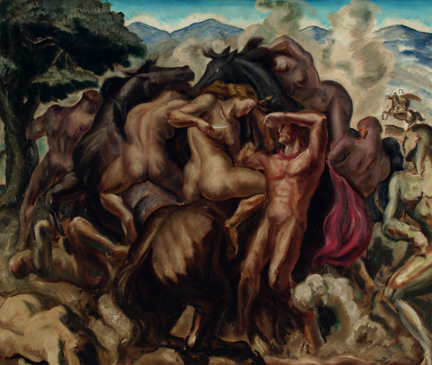
Battle of the Amazons
In 1928, he (Curry) had just come back from Paris, from an eight-month period of study in Paris, where he really studied figure drawing. He had seen the work of Picasso and Matisse. But what really stayed with him in Paris was the experience of the Louvre and seeing painters like Peter Paul Rubens or Eugene Delacroix, Jacques Louis David-the great history painters who took issues of their time or timeless issues and recast them in ways that lessons could be drawn from them. So he came back to his studio in Westport, Connecticut, because he had left Kansas 10 years previously. And he began to paint. And when he chose the "Parables," the timeless parables, he set them in a Kansas barnyard, because this is what had shaped him. This was the context that he could understand.
-Excerpt from Patricia Junker's interview on The NewsHour with Jim Lehrer, August 13, 1998. Interviewed by Elizabeth Farnsworth.
Curry’s fascination with the grand traditions of European art had begun as a child, inspired by reproductions of paintings his parents acquired during the European honeymoon. His mother decorated the walls of their Kansas farm home with prints after works by Giovanni Bellini, Rubens, and other Old Masters. It was not, however, until his study in Paris in 1926-27 that the aspiring painter had the opportunity to admire firsthand the paintings recalled from his childhood. While taking classes with the Russian academician Basil Schoukhaieff to improve his draftsmanship, he also lingered in the Louvre, which, his biographer noted, served in essence as “a second art school for Curry.” In the heady and inspirational company of Delacroix and Géricault, Courbet and Daumier, it was the older works that particularly impressed the young American, most especially Rubens. Technical notes – for example, on Ruben’s use of raw sienna in his underpainting – are inscribed on Curry’s Paris-period drawings; and later paintings…in composition as well as technique, the Flemish example proved influential, as suggested by several drawings and watercolors of battling figures that were apparently inspired by Ruben’s baroque designs.
Excerpt from Charles C. Eldrige's John Steuart Curry’s Hoover and the Flood, published by the Morris Museum of Art